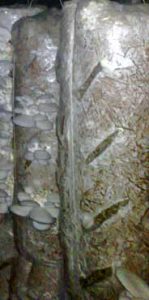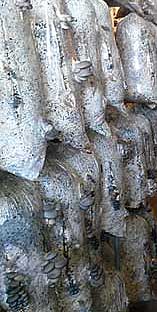It is necessary to make holes in the block as soon as possible after inoculation, since the growing mycelium actively breathes and cannot develop without normal gas exchange in the substrate.
When you make the substrate yourself, it is advisable to perforate it on the day of inoculation, after hanging it in the incubator.
If the cuts are not made within two days, the activity of the mycelium decreases. Therefore, spores of mold and bacteria, which do not need much air, come to life and grow.
Then spoilage of mushroom blocks is possible.
Through the holes, the growing mycelium actively consumes oxygen and releases carbon dioxide and water.
But there should not be too many perforations, otherwise the substrate will lose a lot of moisture.
About incubation of mushroom blocks
Round holes on the block are made with a punch. This is a round iron tube sharply sharpened at one end. Its diameter is 2.5-3 cm. Often the punch is not just sharpened, but the sharp edges are made with teeth.
It is most convenient to make longitudinal cuts with a clerical knife, breaking off the blade into one segment after cutting through 20-30 blocks.
Cross-shaped holes are also made with a clerical knife. Such incisions are recommended to be made so that the petals of the hole cover the slot and it does not dry out. I think that it is much more correct to keep the necessary conditions for incubation than to come up with some kind of "protective" measures. The petals covering the holes do not allow the mycelium to breathe normally, and this can slow down its development.

The number of holes in a mushroom block depends on its weight and size.
How many perforations should be done in a 11-13 kg mushroom block?
It is also important for us to know the answer to the question:
How big is holes for mushroom bags?
The most common and well-established cutting methods are:
- holes are round (punched) - 7-8 pieces each from two opposite sides, with a diameter of about 1.5 - 2 cm.
In the photo above - a block with one-sided perforation, weight 14-15 kg, number of holes - 21. Although here 18-19 perforations would be enough. But, as you can see, the substrate is remarkably overgrown.
At this enterprise, oyster mushroom clusters are packed only in packaging, so they need small druses, but a lot.
- if you cut holes with a clerical knife - there should be 4-5 of them on each side, 5-7 cm long (a large cut does not need to be made as the film is slightly torn after a cut).
The cuts should be vertical, or slightly beveled ("herringbone"), as in the photo on the left.
If your blocks lie horizontally in the chamber, then the cuts made vertically along the height of the bag will turn into horizontal ones.
In the photo - (click to enlarge) bags from one batch with vertical cuts, which hung during incubation, and then were hung vertically and tied horizontally in different chambers.
There are options for placing blocks in the growing chamber, where one-sided perforation is used, then microperforation is made on the opposite side - holes with a diameter of about 1 mm, but over the entire surface of the film.
Microperforation can be omitted if the bag diameter is up to 22 cm. I draw your attention! It is the diameter, not the width of the package!
If the bag diameter is up to 22 cm, gas exchange proceeds normally without small holes.
It often happens that the mycelium tries to crawl out into the microperforation and form primordia. But the holes are so small that the primordia die and can rot. Therefore, I recommend - if you are perforating bags on one side, then it is better to make them with a diameter of 19 to 22 cm than to make a large diameter and microperforation on the other side.
I think so. Then the rows will be doubled, which significantly saves space in the chamber. And the yield with a diameter of up to 22 cm is the same, both with one-sided and with two-sided cuts.
There is an opinion that it is better to perforate after two or three days, so that the mycelium is in the "star" stage, that is, it begins to fluff. This allegedly gives it a head start over contaminant competitors. I believe this is a mistake. From experience I see that bags perforated after three days grow much worse, their yield is lower. However, you can also conduct a couple of experiments, and choose the option that suits you.
If there are too many cuts, then moisture will quickly evaporate through them, and this can negatively affect the yield, especially if the substrate is dry.
When waterlogging the substrate, you can try to reduce its moisture by making extra holes.

After the second flush, you can cause the oyster mushroom to come out in this way: in places free of cuts, a rather long incision is made along the bag.
It is important not to damage the masses of fungal hyphae under the film, so it needs to be slightly drawn off. In these places, mushrooms begin to set en masse.
Most often in clusters of two to three fruiting bodies, but in 3-4 places at the same time.
So you can increase the yield and, after the second flush, collect a sufficiently large amount of oyster mushrooms at the same time.
No, it doesn't. But, in round holes, clusters form a smaller number of mushrooms. Their weight is less than that of clusters that are made with a knife. However, there are more round holes in the bags, so the total weight of all picked clusters does not differ.
After harvesting the first flush, a lump of dense mass may remain in the perforation.
Most often this happens when turning the oyster mushroom clusters on a straw substrate.
This hole needs to be cleaned. As for me, it's easier to do this with your fingers, better with gloves. Just pick up this mass with your finger, like a hook, and carefully pull it out, you can even with a small piece of straw. If a lot of substrate mass comes off, then it is necessary to hold the edge of the film near the perforation with the other hand.
You can not clean the slot if there is a white dense mass on only one edge. If the entire incision is clogged, then the second flush will not begin until the mycelial hyphae grow from the edge of the film over the white lump. The nutrition of such a bunch is very limited, so the second flush on such blocks is weak, or may not start at all.
Read about Oyster mushroom yield
